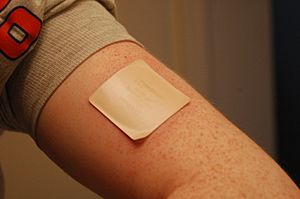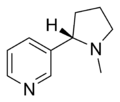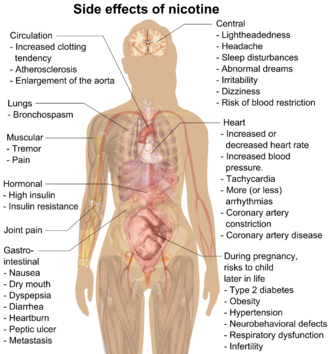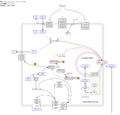Nicotine facts for kids
Nicotine is a drug found in tobacco cigarettes, cigars, pipe tobacco, and chewing tobacco. Nicotine is an addictive stimulant that causes the heart to beat faster and makes blood pressure rise. It can also make a person feel less hungry and speeds up the metabolism. These effects can be very unhealthy. Many people who use tobacco products want to quit but have a hard time quitting. It is one of the most addictive chemicals that is widely consumed by humans.
Nicotine is a substance found in most members of the Nightshade family of plants. Small quantities of it can be found in tomatoes, potatoes, aubergines (eggplants) and green pepper (Capsicum, the peppers used as vegetables). Nicotine is also present in the Coca plant. In higher quantities it is a very efficient poison. It acts on the nerves. It is a stimulant in lower quantities. It is one of the main reasons people are addicted to smoking.
Nicotine is named after Jean Nicot. Nicot was an French ambassador in Portugal. He had some tobacco seeds sent to Paris for analysis (As a drug).
Besides the treatment of nicotine dependency, it seems that the drug can also be used to treat special (severe) forms of epilepsy, as well as some other diseases.
Contents
Cigarette
The amount of nicotine found in one cigarette varies greatly. Factors which influence the amount include type of tobacco; brand of cigarette; country or region (some markets restrict maximum average nicotine levels; and how the cigarette is smoked.
Adverse effects
Nicotine is classified as a poison. At low amounts, it has a mild analgesic effect. At sufficiently high doses, nicotine may result in nausea, vomiting, diarrhea, salivation, bradyarrhythmia, and possibly seizures, hypoventilation, and death.
| Route of administration | Dosage form | Associated side effects of nicotine | Sources |
|---|---|---|---|
| Buccal | Nicotine gum | Indigestion, nausea, hiccups, traumatic injury to oral mucosa or teeth, irritation or tingling of the mouth and throat, oral mucosal ulceration, jaw-muscle ache, burping, gum sticking to teeth, unpleasant taste, dizziness, lightheadedness, headache, and insomnia. | |
| Lozenge | Nausea, dyspepsia, flatulence, headache, upper respiratory tract infections, irritation (i.e., a burning sensation), hiccups, sore throat, coughing, dry lips, and oral mucosal ulceration. | ||
| Transdermal | Transdermal patch |
Application site reactions (i.e., pruritus, burning, or erythema), diarrhea, dyspepsia, abdominal pain, dry mouth, nausea, dizziness, nervousness or restlessness, headache, vivid dreams or other sleep disturbances, and irritability. | |
| Intranasal | Nasal spray | Runny nose, nasopharyngeal and ocular irritation, watery eyes, sneezing, and coughing. | |
| Oral inhalation | Inhaler | Dyspepsia, oropharyngeal irritation (e.g., coughing, irritation of the mouth and throat), rhinitis, and headache. | |
| All (nonspecific) | Peripheral vasoconstriction, tachycardia (i.e., fast heart rate), elevated blood pressure, increased alertness and cognitive performance. | ||
Sleep
Nicotine reduces the amount of rapid eye movement (REM) sleep, slow-wave sleep (SWS), and total sleep time in healthy nonsmokers given nicotine via a transdermal patch, and the reduction is dose-dependent. Acute nicotine intoxication has been found to significantly reduce total sleep time and increase REM latency, sleep onset latency, and non-rapid eye movement (NREM) stage 2 sleep time.
Cardiovascular system
A 2016 review of the cardiovascular toxicity of nicotine concluded, "Based on current knowledge, we believe that the cardiovascular risks of nicotine from e-cigarette use in people without cardiovascular disease are quite low. We have concerns that nicotine from e-cigarettes could pose some risk for users with cardiovascular disease."
Blood pressure
In the short term, nicotine causes a transient increase in blood pressure, but in the long term, epidemiological studies generally do not show increased blood pressure or hypertension among nicotine users.
Reinforcement disorders
Nicotine is highly addictive. Nicotine dependence involves aspects of both psychological dependence and physical dependence, since discontinuation of extended use has been shown to produce both affective (e.g., anxiety, irritability, craving, anhedonia) and somatic (mild motor dysfunctions such as tremor) withdrawal symptoms. Withdrawal symptoms peak in one to three days and can persist for several weeks. Some people experience symptoms for 6 months or longer.
Cancer
Nicotine promotes lung cancer development and accelerates its proliferation. In cancer cells, nicotine promotes the epithelial–mesenchymal transition which makes the cancer cells more resistant to drugs that treat cancer.
Genotoxicity
Nicotine causes DNA damage in several types of human cells.
Pregnancy and breastfeeding
Nicotine has been shown to produce birth defects in some animal species; consequently, it is considered to be a possible teratogen in humans. In animal studies that resulted in birth defects, researchers found that nicotine negatively affects fetal brain development and pregnancy outcomes; the negative effects on early brain development are associated with abnormalities in brain metabolism and neurotransmitter system function. Nicotine crosses the placenta and is found in the breast milk of mothers who smoke as well as mothers who inhale passive smoke.
Nicotine exposure in utero is responsible for several complications of pregnancy and birth: pregnant women who smoke are at greater risk for both miscarriage and stillbirth and infants exposed to nicotine in utero tend to have lower birth weights. A McMaster University research group observed in 2010 that rats exposed to nicotine in the womb (via parenteral infusion) later in life had conditions including type 2 diabetes, obesity, hypertension, neurobehavioral defects, respiratory dysfunction, and infertility.
Images for kids
-
Cigarette ad featuring baseball player Joe Dimaggio in 1941
See also
 In Spanish: Nicotina para niños
In Spanish: Nicotina para niños










